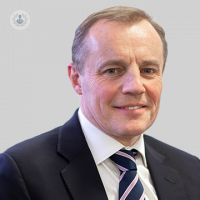Liposuction: how much fat can be removed and will there be scars?
Escrito por:If you’ve followed the book by exercising and dieting but still find that you have some stubborn fat that just won’t shift as you're nearing your goal, liposuction might just be for you. We’ve asked one of our top plastic, aesthetic and reconstructive surgeons Mr Paul Roblin what happens during liposuction, how much fat can be removed and whether you’re left with scarring.
What is liposuction and what happens during the procedure?
Liposuction is a procedure where we try to reduce the volume of body fat by physically removing the fat cells. It can be performed either using a local or mainly a general anaesthetic. We make a very small incision into the skin and we insert a cannula, which is a hollow metal tube, attached to a suction device. By gently moving back and forwards the tube sucks out the fat cells thereby reducing the volume. Following surgery, you’re reliant on the skin to shrink down to reshape and re-contour the body.
Why have liposuction?
Liposuction is to reduce the volume of fat. There are two main things, one is to remove a specific area of fat, say a lump sticking out, or asymmetry. And the other is a more generalised reduction in the volume.
For a very small or specific area, liposuction does extremely well to even out and to gain symmetry. We do use it for a general reduction in volume, but our advice as a medic would be to, first of all, try and use diet and exercise to reduce your weight naturally. For some people, however, this proves difficult and liposuction can certainly help with that.
Who is most suited for liposuction?
The people most suited to liposuction tend to be those who are younger and also people who have specific areas or asymmetry that they are concerned with. Younger patients tend to do better because the surgery is not just about the operation itself but it's reliant on the skin shrinking afterwards once the volume of fat has been removed.
People who are younger do better from that point of view. From a cosmetic perspective, if there’s a lump it can be easily removed and the results are very good. From generalised removal of fat, the results are very good also but you can sometimes get some slight contour abnormalities.
Up to how much body fat can be safely removed?
Fairly large volumes of body fat can be removed, but with the increase in volume then patients can potentially run into problems or complications. For me, in my practice, I would probably limit it to about three litres because it is a cosmetic procedure and as well as trying to get a good cosmetic result, my primary concern is not to give a patient a complication or problems afterwards so I would have a limit on how much I would do it.
Are the results immediate and will there be any scars?
The results are immediate but fairly soon, during and after the surgery there is swelling and bruising. The patient will be put into a compression garment straight away so they will be covered up. I would say it takes up to six to eight weeks to get the final result and during that time, the patient wears the garment. The function of the garment is comfort, to reduce swelling and also to help the skin shrink afterwards.
There are scars because a cannula is actually inside the body sucking the fat out too and when we are making small incisions, we try to place these into the skin creases in order to hide them. The scars are permanent and may start off a little red and lumpy. Over 12 or 18 months, however, they will settle and become softer, flatter and paler.
Are there any reasons not to have liposuction?
In some cases, there are reasons to avoid liposuction as with any cosmetic procedure. First of all, we would take a history from the patient of any medical problems and we make an examination. Our priority is safety for patients so we want to make sure that they don’t run into complications. If that is the suspected case, we would maybe not recommend surgery.
An example would be patients taking blood thinners as they made bleed afterwards, potentially having a complication.
Patients who do well are patients who have good elastic skin so if it is an elderly patient or someone who has lost a lot of weight, their skin tone may not be as good as in younger patients. They may not get very good results because their skin can be droopy afterwards and we might recommend excisional surgery instead.
Read more: When is the best time to have liposuction
Considering liposuction? Book an appointment with Mr Roblin today via his Top Doctor’s profile here for his expert opinion.



